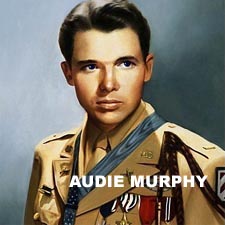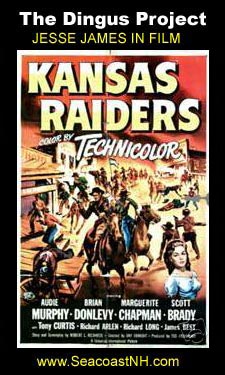| Kansas Raiders |
 THE DINGUS PROJECT
THE DINGUS PROJECT
Jesse James in Film #13
The most decorated American combat soldier in World War II played Jesse James twice, once at the beginning of his acting career and in his final film. Kansas Raiders is a reasonably accurate fictionalized version of how an angry murderous teen fell in with Quantrill’s Raiders during the Civil War.
Kansas Raiders (1950)
80 minutes
Audie Murphy, Brian Donlevy, James Best, Marguerite Chapman
 Audie Murphy plays a teenaged Jesse James during the Civil War even before he began his crime spree. Although 26 at the time, Murphy’s babyface made for a convincing 16 year old Jesse. Brother Frank, two of the Youngers and Kit Dalton (babyfaced Tony Curtis) are also entranced by a para-military organization of thugs and criminals run by "Colonel" William Clarke Quantrill and join his guerilla band. Jesse proves his mettle by defeating Quantrill henchman Rudolph Tate in a knife fight; the two men hold opposite ends of a handkerchief in their mouths while slashing at each other, a concept reprised in the film Long Riders (1980). After winning the fight, Jesse brutally murders his opponent. What he doesn’t know, is that Tate was a spy for the Union Army.
Audie Murphy plays a teenaged Jesse James during the Civil War even before he began his crime spree. Although 26 at the time, Murphy’s babyface made for a convincing 16 year old Jesse. Brother Frank, two of the Youngers and Kit Dalton (babyfaced Tony Curtis) are also entranced by a para-military organization of thugs and criminals run by "Colonel" William Clarke Quantrill and join his guerilla band. Jesse proves his mettle by defeating Quantrill henchman Rudolph Tate in a knife fight; the two men hold opposite ends of a handkerchief in their mouths while slashing at each other, a concept reprised in the film Long Riders (1980). After winning the fight, Jesse brutally murders his opponent. What he doesn’t know, is that Tate was a spy for the Union Army.
Despite major historical inaccuracies, this film plays surprisingly well today, capturing the essence of the brutal world in which Jesse came of age. Unlike many cheesy westerns in the Jesse James film canon, the settings here look real, not staged. The action is believable and the cinematography is powerful. Quantrill (played by veteran actor Brian Donlevy) is convincingly obsessed and grows increasingly crazy. In real life both Donlevy and Murphy joined the military and went to war when they were very young. A certain deadly urgency in each actor infuses the film with a realism missing in many others. Even as Quantrill’s egomaniacal personality is revealed, Jesse remains inexplicably loyal. It is a loyalty of personality that the two actors carry off.
Audie Murphy is known as the "most decorated combat soldier" in World War II, a title he did not like, but was unable to escape after he appeared on the cover of LIFE Magazine. He was also voted among the 100 sexiest men in American film. Murphy reportedly suffered from post traumatic stress disorder (PTSD) and had violent mood swings and agonizing nightmares. A convincing actor, he reprised his role as Jesse James nearly 20 years later in the 1969 film A Time for Dying, that ironically was his last film. He died in a plane crash in 1971. His gravesite at Arlington National Cemetery is reportedly the most visited, after that of President John F. Kennedy.
Like many films, Kansas Raiders attributes Jesse James brutal career as an outlaw to the "warped" training under the Black Flag of guerilla William Quantrill, who imagined he was aiding the Confederate cause until Robert E. Lee himself rejected him. But unlike other films, this one does not attempt to excuse Jesse for his later actions. It merely shows viewers what life was like in Bloody Kansas.
There are lots of historical inaccuracies. Jesse blames Union soldiers for killing his mother and father, when in fact, his step-father went insane and his mother outlived him. Horrified when the raiders slaughter innocent men, women and children, Jesse shoots Quantrill’s associate "Bloody" Bill Anderson. In reality, Jesse rode willingly under Anderson’s command, and even shot a man during a bank robbery whom he suspected had killed his beloved commander bushwacker Anderson.
Audie Murphy, who had experienced the horrors of real war, looks convincingly frenzied by the atrocities inflicted by Quantrill’s raiders. According to this film, Quantrill was able to continually manipulate Jesse because of his youth and inexperience. In reality, Jesse had little to do with Quantrill himself, and, even according to his brother Frank, was among the most bloodthirsty guerillas in the gang.
As in all Jesse James’ films, there is a love interest. This one is tricky, and not successful. Quantrill has a beautiful wife named Kate (Marguerite Chapman) who seems to despise him. From beginning to end she warns Jesse to get away from Quantrill, but both seem to be almost hypnotized. They know Quantrill is evil, demented and deluded. They both tell him so to his face. But they stay. Even when Quantrill’s 450 "bushwackers" raid the town of Lawrence, Kansas and kill 115 men and boys, they stay. They stay right until the bitter end.
Indeed, the film shows that even Quantrill’s men are aware he is deluded and a lost cause. They stay because of the booty. Under the guise of raiding Union troops and pro-Union "Red Legs", Quantrill allows his men to rape, rob and murder to their hearts content. With most of his 100-man band killed or deserted, Quantrill is finally left with only the James and Younger boys, Kit Dalton and Kate. Now blind (is this a reference to King Lear?), Quantrill’s little band hold up in a burned farmhouse. The gang finds a wanted poster offering $10,000 for Quantrill "dead or alive". When the house is surrounded by Union troops, all but Jesse and Quantrill slip away. In his one and only act of bravery, Quantrill pushes Jesse out of the house and leaves by the front door in a blaze of glory. In reality, Jesse James had returned home after being wounded and was not around when Quantrill was ambushed and killed by Union soldiers.
Quantrill’s real life wife Sarah Katherine King did live with her husband at their camp, a place that post-9/11 audiences will see as hauntingly similar to a terrorist cell induction center. She was 17 when Quantrill died in 1865. In Kansas Raiders, Kate shows no grief over her husband’s death. Jesse pledges his love to her as the ending of any B-western demands, but they both know it can never be. Historically Jesse was being nursed for his wounds by his cousin Zee, but here he rides into the dawn light of his outlaw career. Kate may be passive here, but Quantrill’s wife was depicted as a female gunslinger in earlier films like Renegade Girl (1940) and The Woman They Almost Lynched (1953).
Copyright © J. Dennis Robinson and SeacaostNH.com. All rights reserved.
INTERNET MOVIE DATABSE web page


